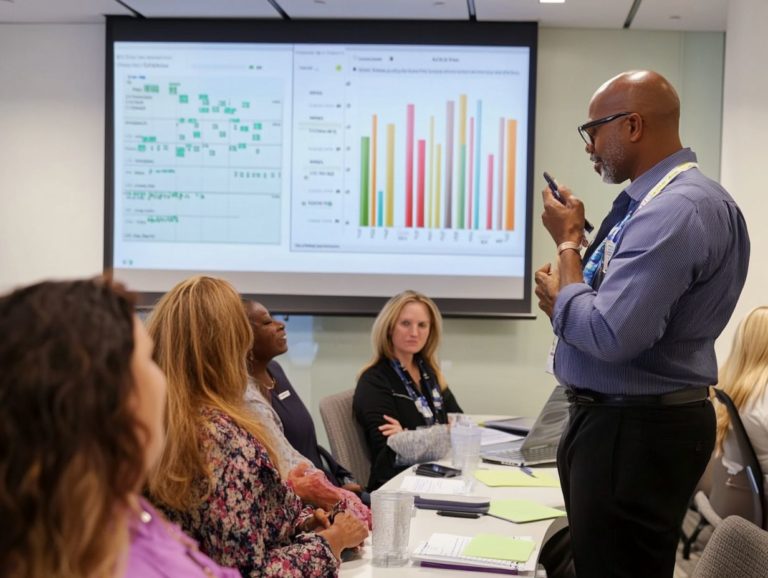How to Align Skill Enhancement with Business Goals
In today s competitive landscape, the success of your business hinges on more than just innovative ideas and effective marketing strategies. Now is the time to enhance your team’s skills and drive your business forward!
Continuous skill enhancement is pivotal in achieving your business goals. This article delves into the connection between skill improvement and reaching your objectives. It guides you through the process of identifying key goals, assessing your current skill sets, and developing tailored enhancement plans.
By implementing strategic methods and tracking your progress, you can ensure that your team’s growth aligns perfectly with your business aspirations. Discover how ongoing skill development can truly be a game-changer for your organization.
Contents
- Key Takeaways:
- The Importance of Skill Enhancement for Business Success
- Identifying Key Business Goals
- Assessing Current Skill Set
- Developing a Plan for Skill Enhancement
- Implementing Skill Enhancement Strategies
- Tracking Progress and Measuring Success
- Continuing to Align Skill Enhancement with Business Goals
- Frequently Asked Questions
- What is the importance of aligning skill enhancement with business goals?
- How can I align my personal skill development with business goals?
- How can managers ensure that their team’s skill enhancement is aligned with business goals?
- What are the potential risks of not aligning skill enhancement with business goals?
- How can a company measure the success of aligning skill enhancement with business goals?
- What steps can a company take to ensure continuous alignment between skill enhancement and business goals?
Key Takeaways:

- Skill enhancement is vital for business success.
- Identify your key goals to determine which skills to enhance.
- Regularly assess and adapt skills to meet changing needs.
The Importance of Skill Enhancement for Business Success
Skill enhancement stands as a cornerstone for your business success, enabling you and your employees to align skills with the organization s strategic objectives. By investing in comprehensive training programs, you can cultivate a culture of continuous learning that elevates employee engagement and enhances overall performance.
This alignment between skill enhancement and organizational goals lays a strong foundation for talent management, which is the process of attracting, developing, and retaining skilled employees. It ensures that your team is well-equipped to meet the ever-evolving demands of the market.
How Improving Skills Can Impact Business Goals
Improving employee skills can profoundly influence your business goals by boosting productivity and fostering innovation within your teams.
When your teams develop effective coaching skills, they not only elevate their individual performance but also cultivate a culture of continuous learning and improvement. For example, a marketing team that regularly evaluates its members’ abilities can pinpoint specific areas for growth, such as digital campaign strategies or data analytics.
By implementing targeted training sessions based on these assessments, the team can enhance efficiency and collaboration. As team members start coaching one another, they exchange valuable insights and techniques, paving the way for innovative solutions.
This collaborative spirit ultimately propels your organization toward its objectives, significantly enhancing overall success through measurable performance improvements.
Identifying Key Business Goals
Identifying key business goals is essential for aligning employee training programs with your organization s vision and mission. This way, every team member will grasp their role in driving success forward.
Understanding the Objectives and Needs of the Business
Understanding the objectives and needs of your business is essential for effective employee training. It enables you to tailor your programs to meet specific requirements.
To accomplish this, you can leverage studying market trends and skills mapping as powerful strategic tools. By diving into industry trends, competitor strategies, and your internal capabilities, you gain valuable insights into the skills and competencies necessary for success.
This thorough analysis allows you to identify gaps within your workforce. It ensures that the training you provide is not only relevant but also closely aligned with your overarching business goals. By aligning your training objectives with these outcomes, you enhance the effectiveness of your programs, resulting in a more competent workforce that is well-equipped to tackle challenges and drive growth.
Assessing Current Skill Set

Assessing the current skill set of your employees is crucial for identifying skills gaps and ensuring that training programs are precisely tailored to address the specific needs of your organization.
By doing so, you can unlock potential and foster a culture of growth and development within your team.
Ready to align your skills with your business goals? Let s get started!
Evaluating Strengths and Weaknesses
Evaluating the strengths and weaknesses of your employees is crucial for crafting effective training programs that promote continuous learning and growth. This process shines a light on where individuals excel and uncovers opportunities for improvement.
Getting feedback from employees and customers is essential! Employees can share their perceptions of leadership and workplace dynamics. Meanwhile, customer feedback provides a clear view of how your services or products are received in the marketplace.
By analyzing this data, you can design learning programs tailored to specific needs and objectives. This ultimately enhances employee capabilities and supports robust ways to manage risks in the workplace. Informed measures help mitigate potential risks by cultivating a skilled workforce prepared to address challenges effectively.
Developing a Plan for Skill Enhancement
Crafting a structured plan for skill enhancement is essential for equipping your team with the tools and knowledge to achieve training goals and objectives. This thoughtful approach fosters growth and enables employees to excel in their roles.
Setting Goals and Creating a Timeline
Setting SMART goals is vital for creating measurable outcomes in your training process, enabling you to track progress effectively. SMART goals ensure clarity and focus in employee development.
By defining clear objectives, you can assess whether individuals are acquiring the skills and knowledge they need to excel in their roles. Incorporating these goals into performance analysis highlights areas for improvement and boosts overall productivity.
Establishing a timeline for achieving these goals is essential; it instills a sense of urgency and commitment. This ensures that training objectives are met promptly and allows for quick adjustments when challenges arise.
Implementing Skill Enhancement Strategies
Implementing effective skill enhancement strategies is key to providing employees with the training they need to excel. This enables them to thrive individually and significantly contributes to the overall success of the organization.
Methods for Improving Skills

There are numerous strategies for enhancing skills, from formal training sessions and compliance courses to valuable on-the-job development opportunities.
These methods can significantly bolster your competence and confidence. For example, formal skills training consists of structured workshops or courses that provide industry-specific knowledge. Compliance training ensures you are informed about the regulatory standards and ethical practices pertinent to your field.
On-the-job development, like mentorship programs, allows you to learn in a real-world context, enabling the immediate application of new skills. Companies like Google and IBM have effectively implemented these approaches, resulting in increased productivity and higher employee satisfaction. This illustrates the vital importance of cultivating a strong learning culture within the workplace!
Tracking Progress and Measuring Success
Tracking progress and measuring success are vital elements of any employee training program. These practices help you understand how well your training is working, allowing you to refine and elevate the training experience.
Monitoring the Impact on Business Goals
Monitoring the impact of your training programs on business goals allows you to evaluate their effectiveness and make necessary adjustments for ongoing improvement. This process goes beyond just assessing immediate outcomes; it also involves contemplating long-term performance trends.
By analyzing metrics like productivity, sales figures, and employee feedback, you can uncover valuable insights into how your training initiatives influence overall engagement and retention. Regular assessments are essential tools for ensuring that your training remains aligned with your ever-evolving company objectives.
These evaluations can reveal areas that require further development, enabling you to change your approach in your training strategy. Take this proactive approach to cultivate a vibrant culture of continuous learning, enabling your employees and ultimately elevating your organization’s success.
Continuing to Align Skill Enhancement with Business Goals
Aligning your skill enhancement efforts with your business goals is essential for successfully navigating the ever-changing landscape of today’s business environment. Understanding why skill enhancement should be a priority fosters ongoing development that effectively addresses evolving needs.
The Importance of Ongoing Development and Adaptation
Ongoing development and adaptation are essential elements of a successful training strategy. They ensure you remain relevant and engaged in an ever-evolving workplace culture.
By actively seeking employee feedback, your organization can fine-tune training initiatives to meet the specific needs and preferences of your workforce. This proactive approach not only amplifies the effectiveness of training programs but also showcases a genuine commitment to listening to employees.
When you feel your input is valued, it naturally leads to higher satisfaction levels, improved morale, and ultimately enhanced overall performance. A responsive training environment creates a positive feedback loop, reinforcing the significance of continuous improvement and adaptability within the organization.
Frequently Asked Questions

What is the importance of aligning skill enhancement with business goals?
Aligning skill enhancement with business goals is a game-changer for your company’s success. Knowing how to align training with business goals ensures that employees are equipped with the necessary skills to effectively contribute towards achieving the overall objectives of the organization.
How can I align my personal skill development with business goals?
One way to align personal skill development with business goals is by regularly evaluating your skills against the skills required for your role and the goals of the company. Identify any gaps and work on developing those skills through training and self-learning.
How can managers ensure that their team’s skill enhancement is aligned with business goals?
Managers can ensure alignment by regularly communicating with their team about the company’s goals and identifying any skills gaps within the team. They can then provide relevant training and opportunities for skill development to bridge those gaps.
What are the potential risks of not aligning skill enhancement with business goals?
Not aligning skill enhancement with business goals may cause inefficiency, lack of productivity, and missed opportunities for growth. This can result in a mismatch between the skills of employees and the needs of the company, leading to a disengaged and demotivated workforce.
How can a company measure the success of aligning skill enhancement with business goals?
A company can measure the success of alignment by tracking key performance indicators (KPIs), which are measurable values that demonstrate how effectively a company is achieving key business objectives. Examples include employee training completion rates, employee performance, and overall company growth and success.
What steps can a company take to ensure continuous alignment between skill enhancement and business goals?
To ensure continuous alignment, a company should regularly review and update its business goals and identify any changes in required skills. It should also provide ongoing training and development opportunities for employees to keep their skills updated and relevant to the business needs.
Conclusion: Continuous alignment between skill enhancement and business goals is critical. Regularly assessing your training programs and making necessary adjustments will not only enhance employee engagement but also drive organizational success. To learn more, explore how to integrate skill enhancement into daily work and start today by evaluating how well your current training initiatives align with your business goals!






